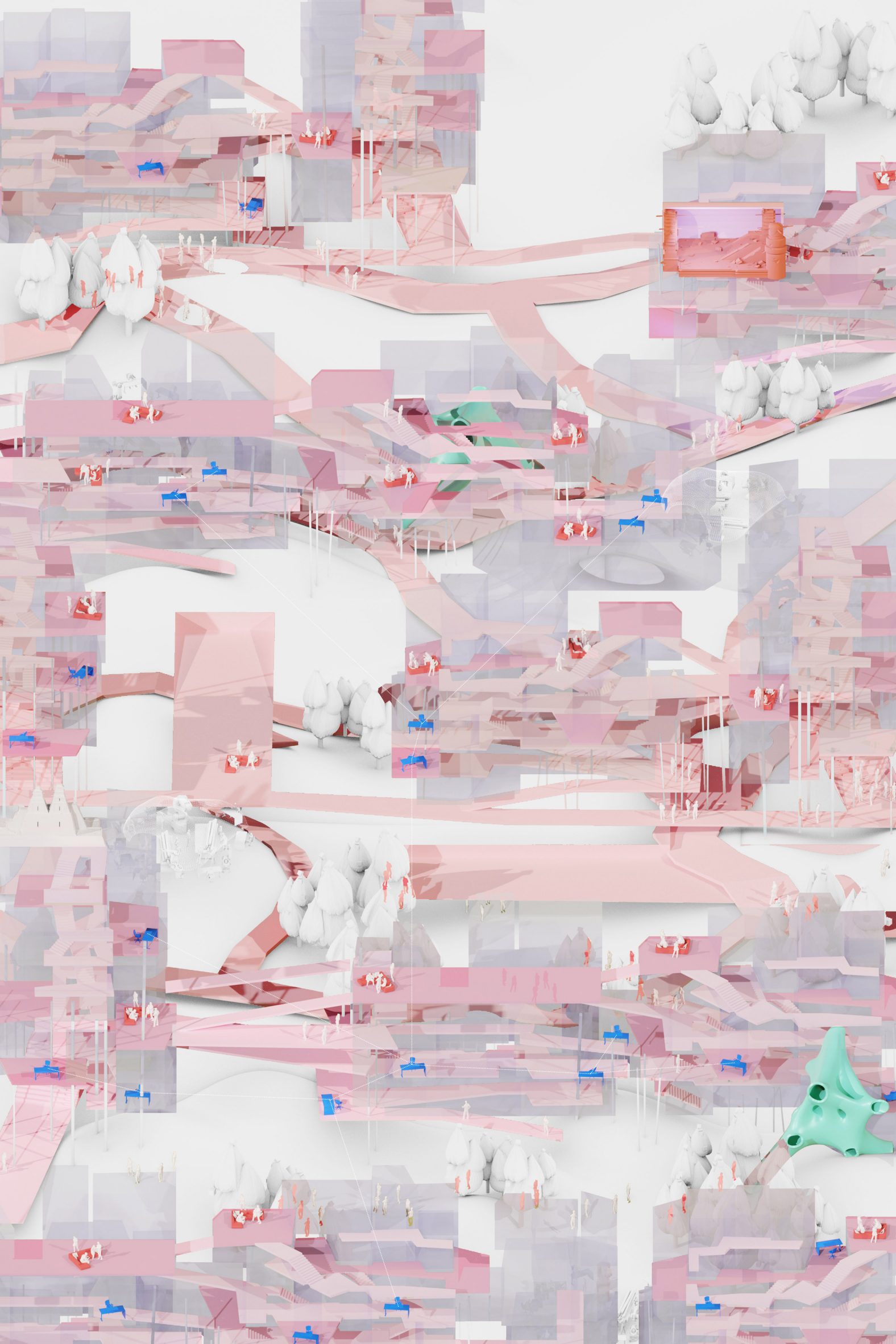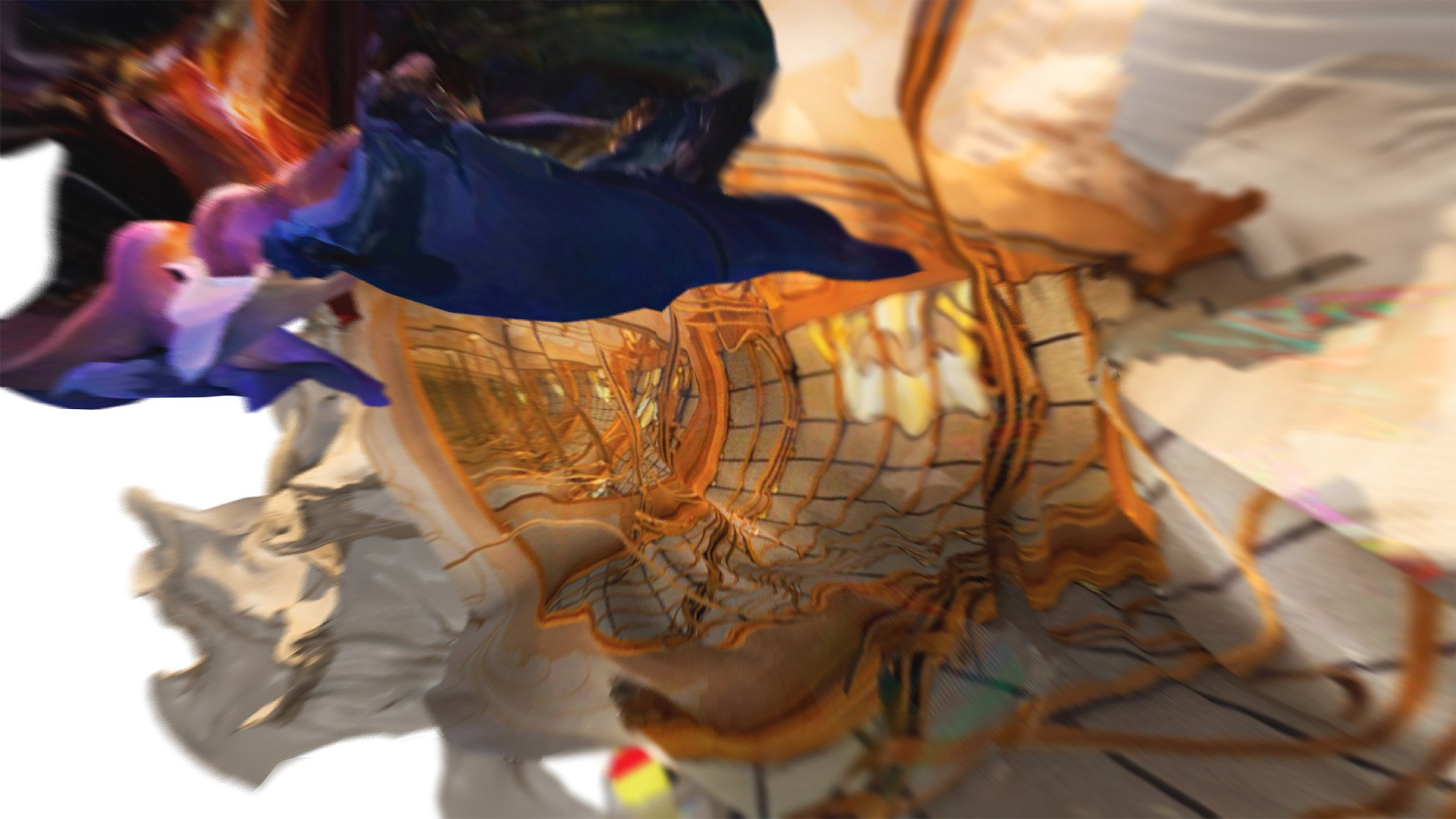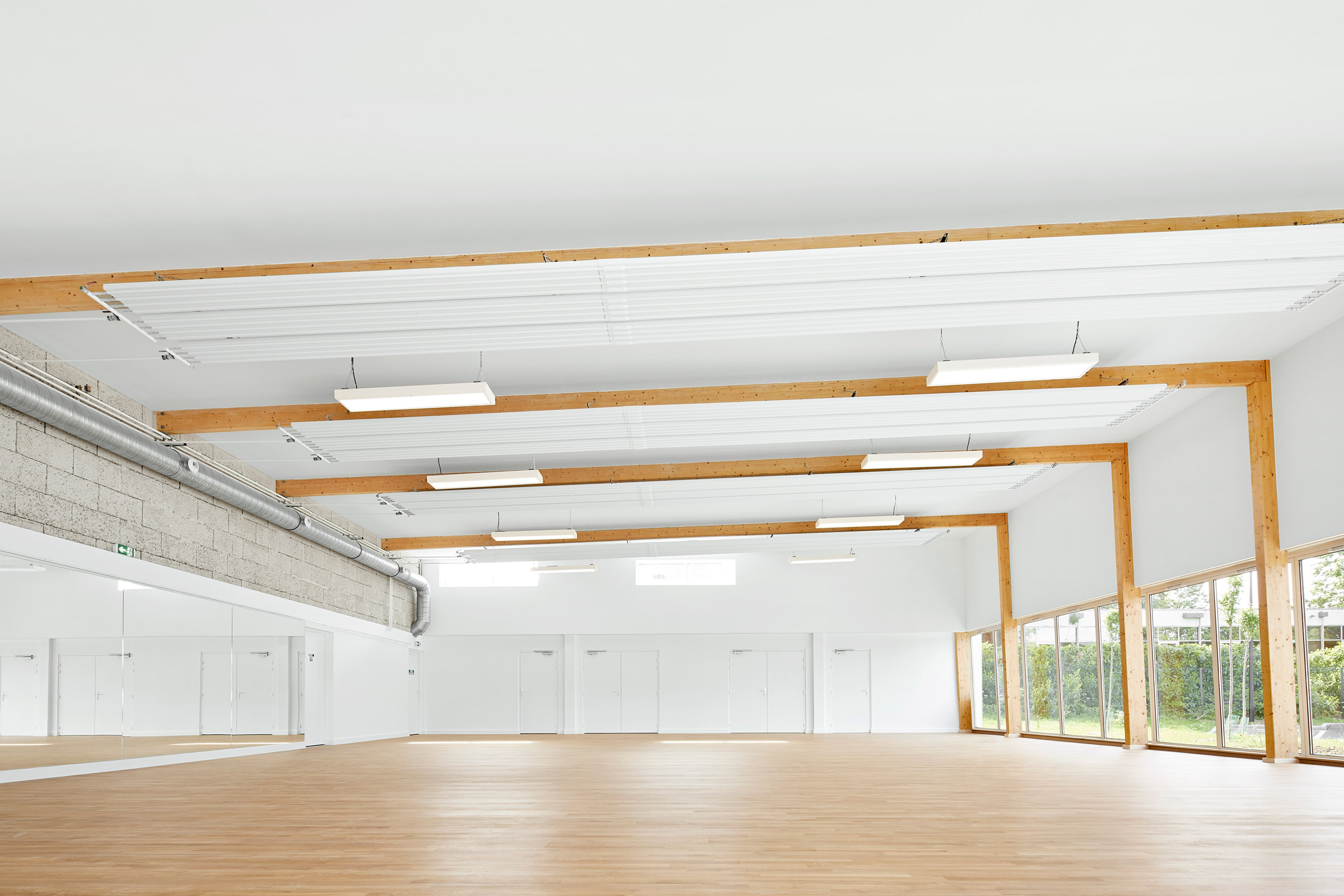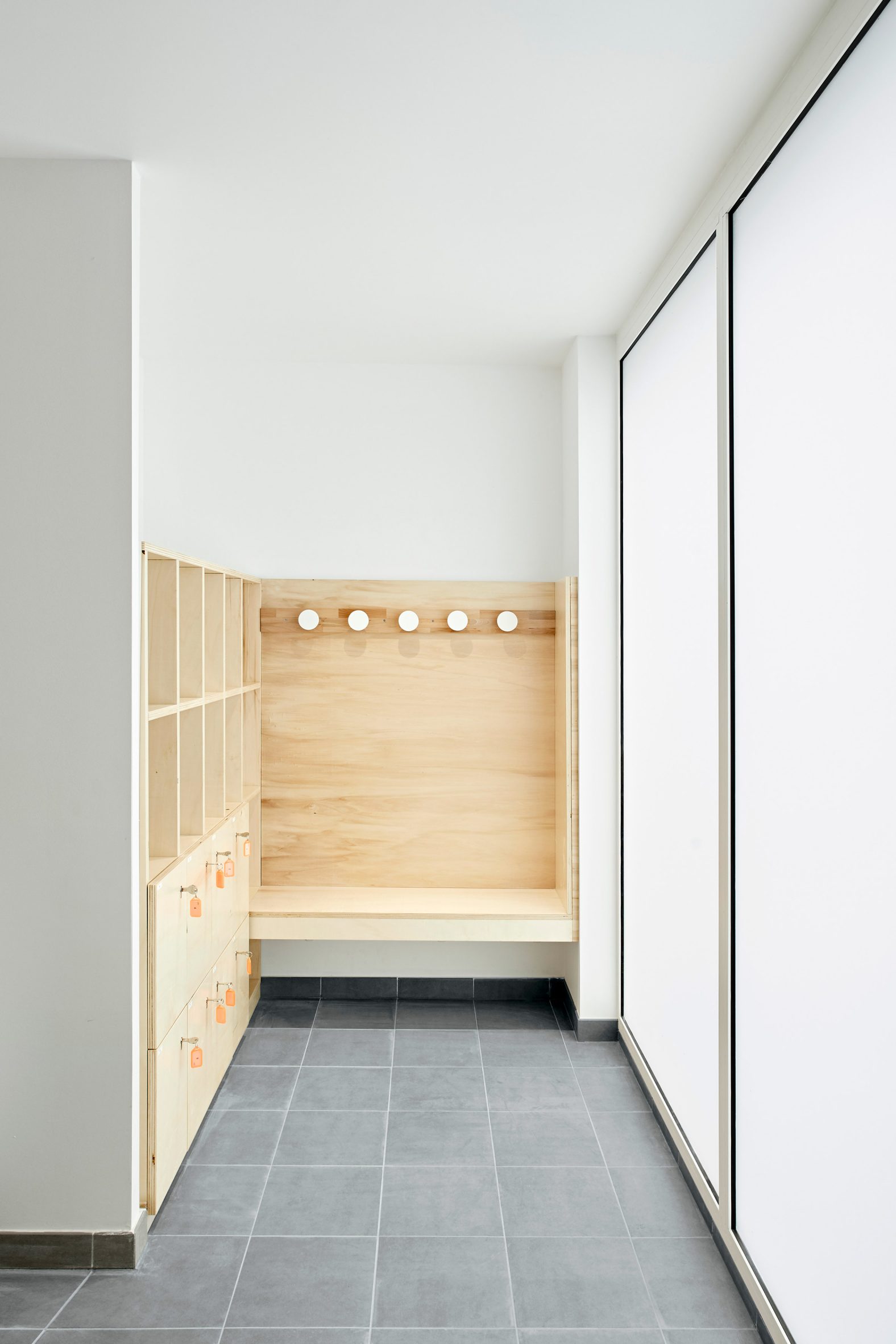
A project that bases a transport system on the mythological Yggdrasil tree and a building informed by a termite mound are included in Dezeen's latest school show by the University of Applied Arts Vienna.
Also included is a project that uses others' perspectives to understand how the world looks, while another explores reducing the number of crossing points between different user groups to minimise pathogen distribution.
University of Applied Arts Vienna
School: University of Applied Arts Vienna, Institute of Architecture
Courses: Architecture
School statement:
"This school show by the University of Applied Arts Vienna's Institute of Architecture features a total of 15 projects in the digital exhibition by students from different year groups at the Austrian architecture school, completed as part of either Studio Díaz Moreno and García Grinda, Studio Greg Lynn or Studio Hani Rashid.
"Studio One: Studio Díazmoreno Garcíagrinda believes that in such a global catastrophe, contemporary urban challenges (migratory fluxes, global pandemics, urban structural deficits, the digital shift, environmental racism, precarious inhabitation conditions and spatial exclusion) are demanding a change of paradigm on architectural thinking and design practices.
"Students' work centres on the extreme conditions of the European Slums, and particularly in the settlement in Pata Rât in Cluj-Napoca. Here the students investigated how architecture can still play a role in such socially and environmentally polluted situations."
"Studio Two: Studio Lynn's students spent the year critically rethinking existing building precedents and inventing new building typologies for short stay living in constructive dialogue with contemporary real-world challenges.
"During the year, a social and cultural practice discouraged people from spending time in elevator cabins and enclosed rooms with strangers and encouraged fresh air ventilation and socialising outdoors. This studio addressed contemporary concerns for healthy, hygienic built environments. The designers' response to the year's global pandemic discovered innovative new concepts and design mediums that can transform how we conceive buildings from now on.
Studio Three: Studio Rashid addressed the current overlapping crises that cities have been facing today and emphasised the emergence of new architectural paradigms and hybrid urban typologies that can serve as contemporary visions towards a positive future."
"This included designing a centre for contemporary art in New York City and rethinking the future of airports and urban interconnectivity by developing a holistic vision of urban mobility and sustainable models of city planning.
MoMAS (Modern Museum of Audible Space) by Emma Sanson, Witchaya Jingjit and Patricia Tibu
"MoMAS is a network of installations, art galleries and spaces for artists to create. Using sound as the connective tissue embodies the ambition of creating a languageless communication between the different components that compose the art world.
"The project not only accommodates sound-related installations, but it is an instrument capable of producing and manipulating sound, with its design based upon sound visualisation methods derived from the research of physicist and musician Ernst Chladni.
"It is an interconnected collection of spaces created to support, display and integrate art and artists into the city's fast-paced and challenging life."
Student: Emma Sanson, Witchaya Jingjit and Patricia Tibu
Course: Studio Rashid
Tutors: Hani Rashid, Jose Carlos Lopez Cervantes, Sophie Grell, Eldine Heep, Sophie Luger and Lenia Mascha
Email: archi.witchaya[at]gmail.com, emma.sanson9[at]gmail.com and tibu.patricia[at]gmail.com
Traces of Global Warming – Trouble in the Away Away by Jade Bailey
"The incentive is to juxtapose current theory, political and cultural discourse with the unintended and unexpected through the speculation of ideas and spaces.
"The instigating premise of the project is based on the ecological crisis we currently find ourselves within. It is addressed primarily through using traces of global climate change to explore the essence of how we as humans can inhabit and perceive its effects through architectural materiality and spatial qualities. In an attempt to understand how to co-exist with an inevitably tangled future and the sub-nature's it will create."
Student: Jade Bailey
Course: Studio Rashid
Tutors: Hani Rashid, Jose Carlos Lopez Cervantes, Sophie Grell, Eldine Heep, Sophie Luger and Lenia Mascha
Email: jadebailey014[at]gmail.com
Future Traces by Raffael Stegfellner, Shpend Pashtriku and Sarah Agill
"Future Traces is a proposal for Fiumicino Airport, which aims to dissolve the inward-looking nature of today's airports and find a more peaceful, culturally productive coexistence with their surroundings. The master plan creates new urbanist links between the airport, the ancient ruins of Portus and the surrounding residential communities.
"It houses complex water distribution infrastructure, providing flood protection to the shoreline. The water, flowing continuously through the site, is used for various environmental and cultural programmes, superimposed onto the existing airport network.
"This composition aims to define the airport of the future through the optimisation of its technology."
Student: Raffael Stegfellner, Shpend Pashtriku and Sarah Agill
Course: Studio Rashid
Tutors: Hani Rashid, Jose Carlos Lopez Cervantes, Sophie Grell, Eldine Heep, Sophie Luger, Lenia Mascha
Email: rstegfellner[at]gmail.com, s.pashtriku@gmail.com and agillsarah@gmail.com

Paradigm Compostition by Arkady Zavialov and Miriam Löscher
"Compostition denies the existence of the end. Materials and constructions create a structure that lives with time. There is the need for its future destruction, the composting of its remnants to give rise to a new, better life.
"The incompleteness opens up freedom, the bravery to make mistakes and change. These are the attributes of the sustainable world of the future. The future airport will become a self-adaptive ecosystem that responds to environmental and social demands by re-distribution, reshaping or destruction and re-use of the actual facilities. Railway networks along hyperloop and airships provide the new traffic system."
Student: Arkady Zavialov and Miriam Löscher
Course: Studio Rashid
Tutors: Hani Rashid, Jose Carlos Lopez Cervantes, Sophie Grell, Eldine Heep, Sophie Luger and Lenia Mascha
Email: zavialovarkady[at]gmail.com and loeschermiriam[at]gmail.com
Yggdrasil (The Future of Urban Interconnectivity) by Witchaya Jingjit, Patricia Tibu, Simonas Sutkus and Anastasia Smirnova
"Just like the Yggdrasil tree, the project aims at becoming a tool for organising and bringing together different worlds, more specifically different transport infrastructures. At the same time, it is a critique and a reaction to the obsoletion of the airport typology as we currently know it.
"The ambition is to work with pollution as an unavoidable byproduct of air travel and integrate it with our architecture as such. The proposal wishes to become a gate figure for the city; a threshold element that is informed by far more than the functional aspects of air travel."
Student: Witchaya Jingjit, Patricia Tibu, Simonas Sutkus and Anastasia Smirnova
Course: Studio Rashid
Tutors: Hani Rashid, Jose Carlos Lopez Cervantes, Sophie Grell, Eldine Heep, Sophie Luger and Lenia Mascha
Email: archi.witchaya[at]gmail.com, tibu.patricia[at]gmail.com, simonassutkus[at]gmail.com, anastasiasmiirnova[at]gmail.com
Aerial Meadows by Ebrar Eke and Alina Logunova
"In conventional buildings, volumes and spaces are designed first – infrastructure follows the design decisions. In our proposal, we are reversing this hierarchical system by designing the infrastructure of airflow first, which results in new types of organisations, spaces, volumes, programs and occupations.
"We looked at termites mounds as a reference as they have effective natural ventilation. Air supplies from underground inlets are distributed to upper levels through the system of chimneys and atriums.
"On the upper floor, the ventilation system consists of smaller clusters. Air structures with occupiable spaces create a variety of unique spatial relationships."
Student: Ebrar Eke and Alina Logunova
Course: Studio Lynn
Tutors: Greg Lynn, Martin Murero, Maja Ozvaldic, Bence Pap and Kaiho Yu
Email: ebrareke[at]gmail.com and 15_alina[at]mail.ru
Advection by Olga Filippova, Chenke Zhang and Hao Wu
"Occupiable air infrastructure voids replaces conventional circulation cores and additionally drives vertical airflow. An adopted Ferris wheels concept for our building operates as the only mechanical circulation, providing landing ports into various levels and spaces. Isolated floors are extended from these ports to link all the occupiable spaces."
Student: Olga Filippova, Chenke Zhang and Hao Wu
Course: Studio Lynn
Tutors: Greg Lynn, Martin Murero, Maja Ozvaldic, Bence Pap and Kaiho Yu
Email: hao.wu1302[atgmail.com, zckqinyu[at]gmail.com and filipp.o.a[at]yandex.ru
Bridged Discontinuity by Tobias Haas and Jonas Maderstorfer
"To deal with the challenges of the pandemic, the project aims to minimise the number of crossing points between different user groups. By separating the high duration functions library, museum and work into three independent massings, the motion flows of the users can be kept parallel."
"A public boulevard hosts all the amenities and low duration functions and bridges the three massings and providing an enfilade-like spatial experience transporting people with the programme. The boulevard is defined as a void, providing sufficient ventilation for the areas with the highest intermixing of people."
Student: Tobias Haas and Jonas Maderstorfer
Course: Studio Lynn
Tutors: Greg Lynn, Martin Murero, Maja Ozvaldic, Bence Pap and Kaiho Yu
Email: haastobias[at]yahoo.de and jonas.maderstorfer[at]gmail.com
La torta a Strati by Alina Logunova and Joyce Lee
"This project serves as an investigation on thinking of borders in various ways as means of organising plans based on agent behaviour. Simulations are set up by putting targets of different properties inside the footprint of the building.
"Floorplates, cutouts, voids and volumes are defined based on the agent movement patterns. A different workflow is created to define space based on programmes, volumes and duration."
Student: Alina Logunova and Joyce Lee
Course: Studio Lynn
Tutors: Greg Lynn, Martin Murero, Maja Ozvaldic, Bence Pap and Kaiho Yu
Email: 15_alina[at]mail.ru and joyceleeeee3[at]gmail.com
MixINN by Anna Chakhal-Salakhova and Yiting Yang
"The project aims to create an active hotel as a more socially engaged place, with a high level of interaction between users. At the same time, it intends to bring civic experience to the building by arranging hotel rooms mixed with three 'districts' with different spatial organisations and characters generated from the algorithm.
"The agent-based design method helped us define the space typologies in terms of spatial connectivity, boundary conditions and sizes. By blurring the borderline between activity areas and the hotel rooms, the project stimulates interaction, providing a sense of community and connectivity."
Student: Anna Chakhal-Salakhova and Yiting Yang
Course: Studio Lynn
Tutors: Greg Lynn, Martin Murero, Maja Ozvaldic, Bence Pap and Kaiho Yu
Email: chakhalsalakhova[at]gmail.com and yangyiii.yt[at]gmail.com

All Watched Over by Merve Sahin
"All Watched Over is a digitally mediated and camouflaged interior. It is an impulsing artefact of data and images that are cultivated by the political exiles.
"The interior readapts the theatre and parliament typologies to exchange and circulate visual and linguistic elements, while the exterior envelope employs strategies to trick the surveillance gaze for granting digital anonymity."
Student: Merve Sahin
Course: Studio Díazmoreno Garcíagrinda
Tutors: Cristina Díaz Moreno, Efrén García Grinda, Anna Gulinska, Lorenzo Perri, Zsuzsa Peter and Hannes Traupmann
Email: mmervesahin7[at]gmail.com

Partly Automated Luxury City by Bofan Zhou, Diana Cuc and Iga Mazur
"The project tries to investigate the heterogeneity and richness of the continuous ground floor conditions of the city where the limits between urban and domestic, public and private are diffused.
"The city operates in the post-work scenario in which leisure creates opportunities for the new social relationships beyond biological family to happen through the spatiality of the communal spaces."
Student: Bofan Zhou, Diana Cuc and Iga Mazur
Course: Studio Díazmoreno Garcíagrinda
Tutors: Cristina Díaz Moreno, Efrén García Grinda, Anna Gulinska, Lorenzo Perri, Zsuzsa Peter and Hannes Traupmann
Email: bofan.zhou1996[at]gmail.com, cuc.diaana[at]yahoo.ro and iam.iga.mazur[at]gmail.com

Place of Distinct Voices by Patricia Vraber
"Place of distinct voices wonders how to take others' perspectives to form mental images of how the world looks like through the eyes of others. This new civic is a universe on its own, providing an extensive grid of time and space.
"The visitor experiences it through the architecture of inversion and an infinite archive of people's stories that enhance our empathy and emotions."
Student: Patricia Vraber
Course: Studio Díazmoreno Garcíagrinda
Tutors: Cristina Díaz Moreno, Efrén García Grinda, Anna Gulinska, Lorenzo Perri, Zsuzsa Peter and Hannes Traupmann
Email: vraberpatricia[at]gmail.com

The Otherworldliness by Magdalena Gorecka
"The Otherworldliness, an audio-video production, creates augmented spatial sceneries for an informal and dynamic production and projection of Bollywood movies. It is located in the biggest European greenhouses agglomeration in southern Spain.
"The proposal brings together displaced immigrants from the sub-Sahara. The project manifests in a sequence of artefacts, which tense the voids within a dense and homogeneous polyethene landscape."
Student: Magdalena Gorecka
Course: Studio díazmoreno garcíagrinda
Tutors: Cristina Díaz Moreno, Efrén García Grinda, Anna Gulinska, Lorenzo Perri, Zsuzsa Peter and Hannes Traupmann
Email: goreckagorecka[at]gmail.com

Vertical Suburbia by Alexander Klapsch and Jenny Niklasch
"This project rethinks an intensified urban realm and the reconceptualisation of open space on the periphery of Vienna.
"Through the vertical integration of activities, the built space is densified and seen as a juxtaposition to the negative space, creating an environment of coexistence for humans and other species."
Student: Alexander Klapsch and Jenny Niklasch
Course: Studio Díazmoreno Garcíagrinda
Tutors: Cristina Díaz Moreno, Efrén García Grinda, Anna Gulinska, Lorenzo Perri, Zsuzsa Peter and Hannes Traupmann
Email: alexander.klapsch[at]gmail.com and jenny_niklasch[at]outlook.de
Partnership content
This school show is a partnership between Dezeen and the University of Applied Arts Vienna. Find out more about Dezeen partnership content here.
The post 15 student design projects from the University of Applied Arts Vienna appeared first on Dezeen.
from Dezeen https://ift.tt/3fjPiSo


























